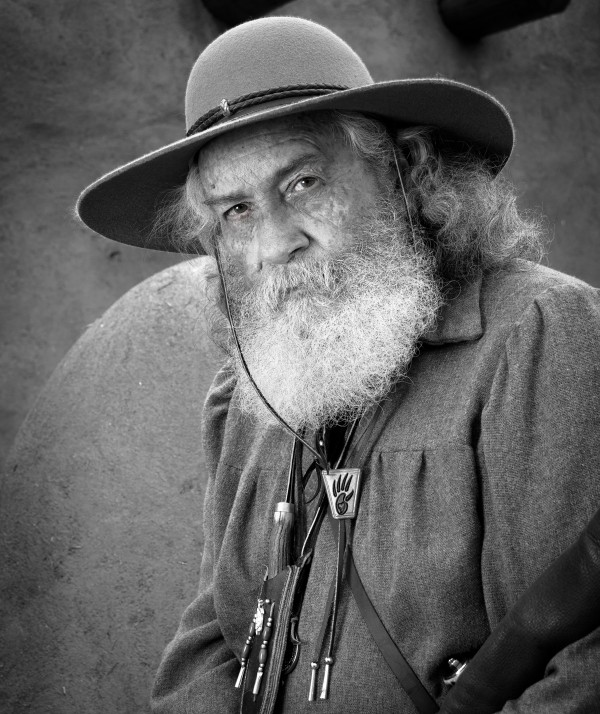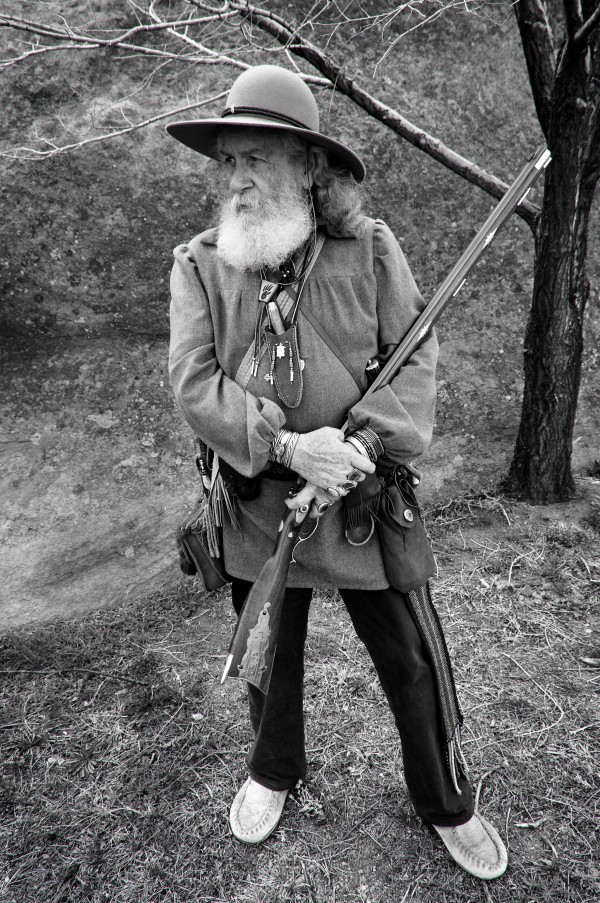Mountain Man Badger Puthoff
Approximately 3,000 mountain men roamed the Rocky Mountains between 1820 and 1840, the peak beaver-harvesting period. While many were free trappers, most mountain men were employed by major fur companies.
Mountain men lived aux aliments du pays, French for “nourishment of the land”, surviving by using the provisions of nature. Eating bull cheese (buffalo jerky) and galette, a basic flour and water bread made into flat, round cakes and fried in fat or baked before an open fire, they lived alone.
Remembering and reenacting that adventure attracts men such as John Puthoff, 74, known as Old Badger. Puthoff spends every weekend being a mountain man so others can appreciate what his life must have been like 200 years ago.
TRIBUTARY
What attracts you to the mountain man lifestyle?
PUTOFF
I do it because I love it. It’s been a part of me since I was a kid. I ran these hills in Deer Creek Canyon (west of Denver) starting in my early teens (early 1950s). I rode the school bus down old Highway 285 along South Turkey Creek to Bear Creek High School. I got to be free as a bird roaming these hills with the same attitude as the mountain men had. They answered to basically nobody. They did what they needed to.
I always had an affinity towards being by myself and learning, watching and understanding things. When I was running the hills here as a kid, I carried a .22 caliber rifle in the leather sleeve that was fringed. I had a tomahawk on my hip, which I still have. I had a knife in a sheath and a pouch full of bullets. What more did I need?
I lived in my own world up there. There was one summer where I didn’t come out of the hills to go into town for probably four or five weeks. I was living a dream that a lot of kids will never get a chance to experience.
When I dress in the mountain man way, I step back 200 years. I try to be as historically truthful and real about the history and lifestyle from the mountain man era. Everything on me is hand made to resemble actual equipment. I carry an English folding knife that is more than 150 years old which my grandfather acquired somewhere along the way.
TRIBUTARY
You are wearing a leather totem of a badger track around your neck. Why the badger?
PUTHOFF
(Pulling his hair back) I also wear badger claw earrings. The native Americans believe each person has an animal guide that accompanies them through life. There may be more truth to many of the Indian legends than many people want to believe.
Seeing badger tracks was a sign of future success to the Indians, a sign that all things are possible when we tap into our inner creative powers. Watching and studying about the badger I have learned to walk my own path at my pace. Never mind what others may say. I have discovered that I am well equipped to take on whatever challenges I face. I also have an attitude like a badger on occasion.
Like my leatherwork. It is from that era but no one taught me how to do it. I discovered it on my own. I’m self-taught. My first day in high school my teacher set a rack of tools down in the middle of the table, backed up and said, “Boys those are leather craft tools. Have fun.”
My grandfather gave me a scrap of leather when I was a kid and the first damned thing I did was make a holster for a cap gun.
Since then I have never stopped creating leatherwork. I have designed many things for many people. I worked for Tandy Leather for about 20 years. I was teaching classes, giving demonstrations, sales. Traveled all over the west. I enjoyed working with people. I am a teacher at heart.
TRIBUTARY
After high school you were on active duty with the Air Force and then you were a surveyor for the Denver Water Board.
PUTHOFF
I loved surveying and did it for about nine years. I worked in a feed store for a number of years. Then started selling my own custom leatherwork. I worked on my own after that for about 30 years. I sold most of my work at gun shows and took a lot of orders for custom designs.
TRIBUTARY
When did you get involved with the rendezvous and what attracted you to those events?
PUTHOFF
I was doing mountain man rendezvous from the 1970s on. I made a buckskin leather outfit back then. Made it in 1975. I would sell my leatherwork there as well.
A rendezvous is a place to relax and enjoy myself and partake of a time period with others who enjoy the same thing. We would trade things. I did some teaching. I love actually showing people how to do something, especially in leather. I have been an educator, a leather craft teacher, since I was a kid.
It’s re-enacting, recreating and stepping back in time to a less stressful situation where you are with like-minded people who are craftspeople and historians. They understand what they are doing. They teach others.
When my wife was alive, we’d go to some of them and spend two or three days. The rendezvous I still like to go to that is close by is in Fort Lupton. The other one I like is here at The Fort coming up on May 18 and 19 — the 13th Annual Indian Market and Powwow.
TRIBUTARY
It sounds like you lost your best companion when she died.
PUTHOFF
She died Christmas Day 2009 suddenly. She wasn’t feeling good. Had an upset stomach. It was about 8 am and I was giving her a back rub. She said it felt great. I took her dishes back out to the kitchen and when I came back she was laying over on her side. She had had a seizure.
It left me lost in space for a while. I dearly loved the lady. She was part of my life for 30 years. I have since re-learned that my world is the one that I am in now. I’m a loner and I am finding out now that is where I belong. That’s where I am comfortable. I am a loner by choice. My traits, my actions since I was a kid, is a loner.
TRIBUTARY
On the other hand you love talking with people here at The Fort and being an educator.
PUTHOFF
Well, but I do it at my pace. Not somebody else’s. If I need to walk away for a while, I do. This is the world I believe I existed in once before. The mountain man was very solitary.
TRIBUTARY
You seem to enjoy being in these red rocks overlooking Denver.
PUTHOFF
I am walking over the same ground that the native Americans walked over 200, 300, 400 years ago. I stand here and look out over the same countryside that they did. I have the same feelings within my heart, the spirituality of everything around me and how the Indians respected all these things, I try to do the same. (Pausing) If I choke up, I’m sorry. It happens. This is the time period and the world in which I am extremely comfortable being a part of and being able to share with other people.
TRIBUTARY
Is there somehow a sense that you were there back then?
PUTHOFF
Very definitely. I’ve been here before.
TRIBUTARY
Your leatherwork business card lists your name as Jacob T. Dof, not John Puthoff. Where does that come from?
PUTHOFF
It’s an acronym for “Just A Cantankeros Old Bastard That’s Damned Old Fashioned.”
TRIBUTARY
Would you describe what you are wearing?
PUTHOFF
The knife I wear around my neck is hand made out of a saw blade. This turtle emblem represents longevity and the Indians used it to represent the American continent.
This is the Cross of Lorraine. It would be carried as a trade piece to give to the Indians. The silver braclets and turquoise, that’s simply me. I’ve worn them since the Sixties. I will not part with them. Mountain men did have earrings and bracelets but not to the extent that I have.
TRIBUTARY
Kind of a Hippie thing.
PUTHOFF
No. Beatnik.
This is my possibles bag. It has fire starting equipment, parts for the guns, whetstone, flint and steel. Your life would have depended on what was carried in the bag. Extra flints, a tin of priming powder. Sometimes a bullet mold.
Remembering Mountain Men I put my foot in cold waterand hold it there: early mornings
they had to wade through broken ice
to find the traps in the deep channel
with their hands, drag up the chains and
the drowned beaver. The slow current
of the life below tugs at me all day. When I dream at night, they save a place for me,
no matter how small, somewhere by the fire. — William Stafford (1914 – 1993)


